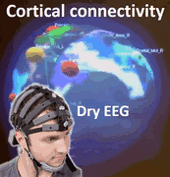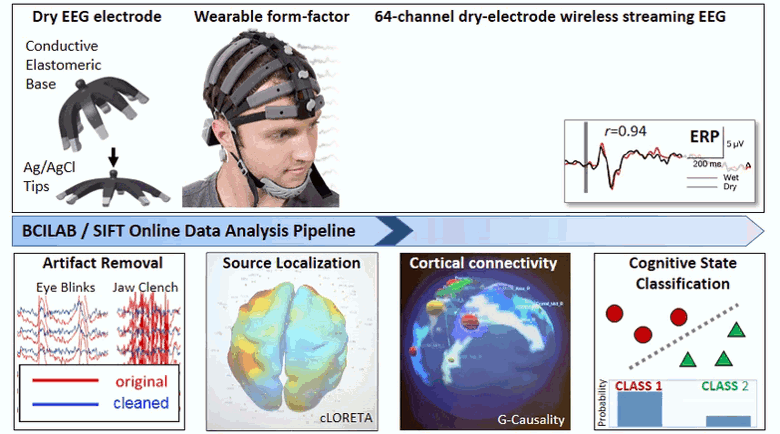In recent years, there have been significant advances in wearable, mobile, dry-electrode electroencephalography (EEG) systems. These are yielding exciting new possibilities for scientific research, clinical diagnostics and therapeutics, and brain-computer interfaces (BCI) outside the clinic or laboratory. However, these systems have been limited to a handful of channels mostly for applications of low-dimensional signal analysis in gaming and command control. Here we describe and evaluate the first high-resolution dry mobile BCI system supporting real-time artifact rejection, imaging of distributed cortical network dynamics, and inference of cognitive state with a 64-channel dry-electrode wireless EEG headset.
The HD-72 headset features a wearable 72-channel (64 EEG + 8 ExG) form factor, compact electronics with active shielding, and a wireless triggering system. Active dry-contact electrodes leverage a pressure-induced flexing mechanism to contact the scalp through hair. We observe comparable dry-electrode signal quality to simultaneously recorded wet electrodes for average evoked responses (AEP, SSVEP, P300 corr. > 0.9) and single trial data. The headset wirelessly streams the 64-channel EEG data for real-time analysis and data visualization. An open-source real-time software framework performs adaptive artifact rejection using Artifact Subspace Reconstruction (ASR), cortical source localization using anatomically constrained LORETA or Beamforming, power and multivariate Granger-causality estimation using sparse vector autoregression via ADMM, and cognitive state classification from time-frequency effective connectivity features using a novel constrained logistic regression method (ProxConn). Demonstration of the framework on dry EEG data showed substantial suppression of signal artifacts, while single-trial classification of Flanker-task response error commission was significantly above chance (AUC 0.74 ± 0.09, N = 9).
The real-time EEG analysis software pipelines are made freely available in the open-source Source Information Flow Toolbox (SIFT) and BCILAB MATLAB toolboxes for EEGLAB. Distributed data acquisition and synchronization are supported by the Lab Streaming Layer (LSL).


